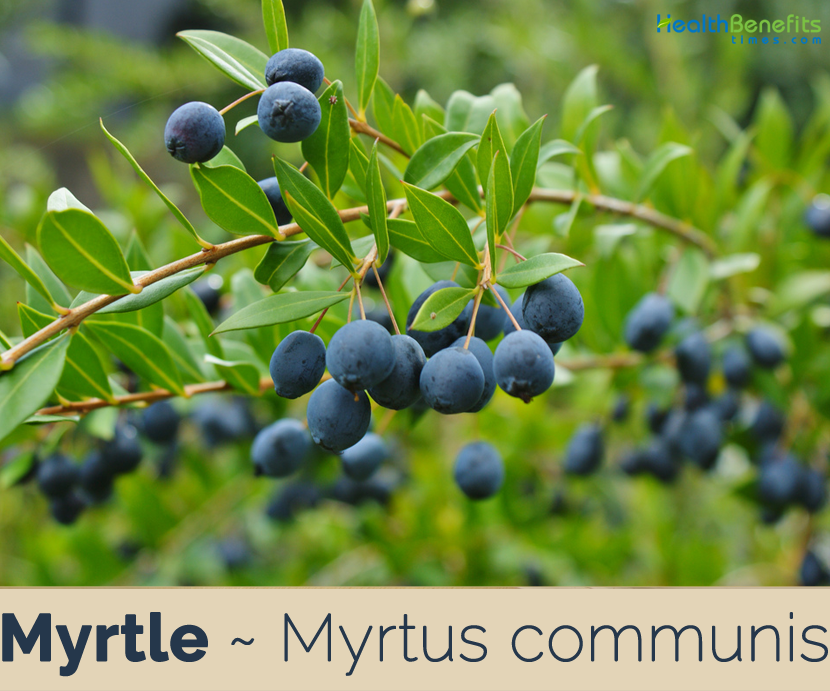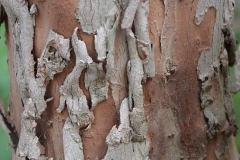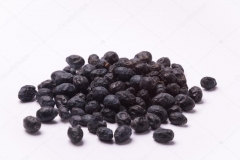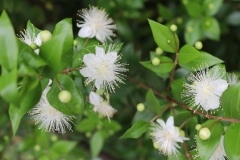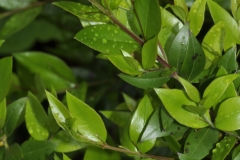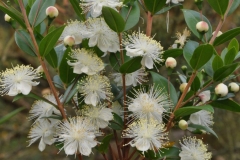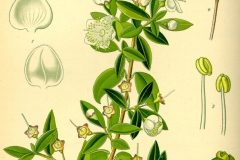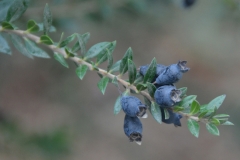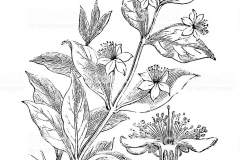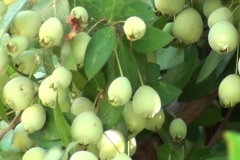Leaves are either dried, almost like bay leaves for culinary applications, or the essential oil is extracted from a wide variety of medicinal uses. Also, the fruit is sometimes used to make alcohol, called mirto, commonly drunk on some of the Greek Isles. However, the most prevailing use of myrtle is the essential oil, which can be applied during aromatherapy and have impressive effects on your health. The essential oil smells similar to eucalyptus and is acquired through steam distillation of the leaves.
Plant Description
Myrtle is an aromatic evergreen perennial shrub or small tree that grows up to 8-12 ft. (243- 365 cm) all and 7-11 feet (240-360 cm) wide but this plant is usually kept smaller with pruning. The plant is found growing near wall side borders, shrub borders, hedges, city gardens, cottage gardens, Mediterranean garden or even containers. The plant succeeds in any reasonably good soil so long as it is well-drained. It prefers a moderately fertile well-drained neutral to alkaline loam soil. Stem is upright, 2.4-3 m tall, branched, thickly covered with evergreen leaves with deep fissured bark.
Leaves
Leaves are glossy, glabrous, coriaceous, opposite, paired or whorled, ovate to lanceolate with stiff structure, aromatic, entire margined, acuminate and 2.5-3.8 cm long, glands are absent in the lamina. The leaves consist of valuable essential oils which are valued for both medicinal uses and culinary applications. Leaves are occasionally used as a substitute for bay leaves.
Flower & Fruit
Axillary white flowers occur on slender peduncles; medium sized about 2 cm in diam., stiff having yellow anthers. The petals are pure white with glands and somewhat tomentose margin covered with fine hairs. They give off a sweet fragrant smell. Flowering normally takes place from July to august.
Flowers are followed by spherical, pea-sized, multi-seeded berries that are orbicular or ovoid-ellipsoid shaped. They are of varying sizes (0.7-1.2 cm) and shapes. The glabrous berry has rounded (vase like) shape with a swollen central part and remnants of persistent 4-5 partite calyx at the outer part. Fruits are initially pale green, then turn deep red and finally become dark indigo when fully mature. When fresh they are soft and aromatic. Beneath the blackish-blue skin the flesh is reddish-purple and is filled with small kidney-shaped seeds. The taste is a cross between Juniper and rosemary, with an initial aroma of pine and eucalyptus. The fresh berries have a somewhat bitter and tannic after-taste.
Berries are edible and may be eaten raw, but are at best moderately tasteful. Dried flowers, leaves and fruits are used to flavor foods. Fresh flowers may be added to salads. Wood and leaves are added to charcoal to flavor grilled meats.
History
This plant was well known and cultivated since antiquity, occupying a noticeable place in the writings of Greek, Roman, and Arabian writers. Following these authors, its ceremonial use was mentioned in the Bible and its medicinal properties quoted by Hippocrates. Theophrastus mentioned it among the cultivated plants, giving advices about its cultivation and describing its morphological characteristics, its fragrance, and its use in the confection of garlands. Dioscorides also mentioned a myriad of medicinal applications of myrtle, explaining, for example, how to prepare myrtle oil with the leaves for treating different skin diseases and how to elaborate myrtle wine with the fruits for digestive problems. Interestingly many of these remedies have been registered in recent ethno botanical surveys.
Alonso de Herrera, a Spanish author of the sixteenth century, mentioned the use of myrtle as a condiment, besides treating how to cultivate it and describing some of the medicinal properties already mentioned by Dioscorides.
Health Benefits of Myrtle
The health benefits of myrtle include a better respiratory health, skin care, boosted immunity, and hormone balance, among others. Listed below are some of the popular health benefits of using Myrtle
1. Cancer Prevention
Myrtle is possibly most highly admired for its high levels of antioxidants, including quercetin, tannins, myricetin, and catechin. These antioxidants have been extensively researched and have been found to have anti-carcinogenic and anti-mutagenic properties. According to a research report in Natural Product Communications Journal, myrtle is quite similar in chemical composition to sandalwood, which has been associated to a reduction in prostate and breast cancer. Ongoing research is still discovering more potential applications in the field of cancer for myrtle. (1), (2)
2. Heart Health
Myrtle consists of various flavonoids including myricetin, that have been shown to reduce the oxidization of bad cholesterol (LDL cholesterol), which means that your cholesterol levels will remain balanced, your blood vessels and arteries won’t be blocked, atherosclerosis won’t occur, and your cardiovascular system will be protected from coronary heart disease and strokes.(3)
3. Skin Care
Myrtle can effectively clear up acne and other imperfections on the skin. It should topically be applied in its essential oil form, often in other carrier oil or in very limited concentrations. Organic compounds and powerful antioxidants in myrtle can help the cells heal quicker and improve the appearance of those affected areas. In its herb form, it can be consumed to see similar effects working from the inside out! (4)
4. Kidney Health
One of the ancient applications of myrtle leaves was for the treatment of urinary tract or kidney issues. Myrtle can help to stimulate urination, thus eliminating excess toxins, salts, fluids, and even fat, thus helping to regulate the functions of your kidneys.(5)
5. Diabetes Treatment
Although Myrtle is still theoretically out on this health benefit, early research indicate that the volatile compounds and flavonoles in myrtle can help to reduce blood sugar plasma, which means that it would be able to help regulate blood sugar in the body. This would be a major boost for diabetic patients who need to monitor their blood glucose levels at all times.(6)
6. Hormone Balance
Extensive research has been carried out around the world regarding the effects of myrtle essential oil on the endocrine system, mainly in regulation of the thyroid gland. It has been shown that myrtle essential oil, whether consumed or inhaled, can certainly affect the release of hormones, including those related to the ovaries and women’s reproductive health.(7)
7. Cognitive Abilities
Myricetin is one of the most important flavonoles that are found in myrtle. It has been found to prevent the formation of beta-amyloid fibril, which means that it is a very powerful aid for people suffering from Alzheimer’s and dementia. The therapeutic use of myrtle leaves and berries can keep your mind clear and prevent the degradation of neural pathways that lead to these terrible cognitive disorders. (8)
8. Improved Respiratory Conditions
As mentioned, myrtle essential oil is very popular in aromatherapy and is commonly used to alleviate respiratory conditions, such as bronchitis and asthma. It calms the respiratory tract and allows for clear passage of oxygen, while also calming the body, so breathing is slowed and irritation is removed. (9)
9. Boosted Immune System
There has been a wide scope of research detailing the antibacterial and anti-parasitic nature of myrtle. For this reason, many people turn to this herb in order to boost the strength of their immune system.(10)
https://www.youtube.com/watch?v=u-VbyCw5bdw
Ethno-botanical uses of Myrtle
| Myrtle Quick Facts | |
|---|---|
| Name: | Myrtle |
| Scientific Name: | Myrtus communis |
| Origin | Southern Europe, North Africa and West Asia |
| Colors | Initially pale green, then turns deep red and finally becomes dark indigo when fully mature |
| Shapes | Spherical, multi-seeded berries that are pea-sized, orbicular or ovoid-ellipsoid. They are of varying sizes (0.7-1.2 cm) and shapes. |
| Flesh colors | Reddish-purple |
| Taste | Bitter, pungent when unripe, sweet when ripe |
| Calories | 89 Kcal./cup |
| Major nutrients | Total dietary Fiber (45.79%) Manganese (37.91%) Copper (31.00%) Iron (26.00%) Calcium (14.20%) |
| Health benefits | Boosted Immune System, Improved Respiratory Conditions, Cognitive Abilities, Hormone Balance, Diabetes Treatment,Kidney Health, Skin Care, Heart Health, Cancer Prevention |
| Parts Used | Description of Preparation | Application | Country (Used) |
|
Leaves alone |
Leaves have been used as an input for preparing liqueur called Mirto. | Beverages | Italy |
| One gram of tea mixed with leaves has been drunk on daily basis. | Stress and anxiety | Turkey | |
| Aqueous maceration of leaves can be taken after filtration and concentration | Depression, polymenorrhea, and wound | Iran | |
| The decoction of the leaf powder Not specified | Hypertension, eczema and other skin diseases Respiratory disorders and hemorrhoids | Algeria | |
| Leaves are boiled and the stock is drunk (Turkey) Juice of leaf is taken orally in the morning (Ethiopia), others unspecified | Abdominal pain and diarrhea | Pakistan, India, Turkey, Iran, Ethiopia | |
| Rural women mix the leaf extract with raw butter and apply it to their hair | Cosmetics (hair fall control) | Ethiopia | |
| Bathing with crushed fresh leaves | Dandruff | Ethiopia | |
| Dried leaf powder mixed with butter is applied topically | Scabies | Ethiopia | |
| The leaves are crushed, boiled with water, and are then drunk | Headache | Ethiopia | |
| The dried aqueous extract (leaf powder) | Sinus infections | China, France | |
| Dried leaf powder | Tinea capitis and as anti-pyretic and sedative agent | Ethiopia | |
|
Leaves, berries and myrtle oil |
Depending on the nature of the disease states and parts of the plants used (remains unspecified) | Diarrhea, dysentery, gastric ulcer, vomiting, rheumatism, hemorrhages, deep sinuses, leucorrhea Hemorrhoid, inflammation, pulmonary and skin diseases An astringent, antiseptic, disinfectant and hypoglycemic agent | India, Pakistan, Turkey, Ethiopia, Iran |
| The aqueous juice has also been used for the preparation of food and wines | Food and drinks | Europe (Italy) | |
| Myrtle oil | Adjunct for the treatment of insomnia | Ethiopia | |
| Leaves and fruits | Unspecified | Vulnerary, cough suppressant, and digestant effects | India, Pakistan |
Traditional uses and benefits of Myrtle
- Leaves are aromatic, balsamic, haemostatic and tonic.
- Recent research has discovered a substance in the plant that has an antibiotic action.
- Plant is taken internally in the treatment of urinary infections, digestive problems, vaginal discharge, bronchial congestion, sinusitis and dry coughs.
- It is considered to be useful in the treatment of cerebral affections, especially epilepsy in India.
- Externally, it is used in the treatment of acne, wounds, gum infections and hemorrhoids.
- Leaves are picked as required and used fresh or dried.
- An essential oil obtained from the plant is antiseptic.
- It consists of the substance myrtol – this is used as a remedy for gingivitis.
- Oil is used as a local application in the treatment of rheumatism.
- Fruit is carminative and is used in the treatment of dysentery, diarrhea, hemorrhoids, internal ulceration and rheumatism.
- Infusion of leaves can be used internally to treat urinary tract infections, indigestion, bacterial vaginosis, coughs and sinusitis, as a mouthwash for gum disease and a wash for skin infections.
- Fruit infusion is used to treat diarrhea, dysentery, internal ulcers and externally for hemorrhoids.
- Essential oil can be used as a topical treatment for acne, as a rub for rheumatic pain and as a general antiseptic.
- Decoction of leaves and fruits is used as stomachic, hypoglycaemic, anti-microbic, cough and oral diseases, for constipation, appetizing, anti-hemorrhagic.
- Fruit decoction was used to bath new-born with reddened skin.
- Decoction of leaves and fruits was useful for sore washing.
- Decoction of the leaves is still used for vaginal lavage, enemas and against respiratory diseases.
- Fixed oil obtained from berries strengthens and promotes growth of hair due to hair tonic property.
- Different parts of the plant have been used as medicine, mainly to treat digestive and respiratory diseases or in external use as anti-inflammatory and to treat skin diseases.
- Raw consumption of the fruit is popularly considered good against diarrhea and a vitamin-rich tonic.
Culinary Uses
- Fruit can be consumed raw or cooked.
- Fruit has an aromatic flavor; it can be eaten fresh when ripe or can be dried and is then used as an aromatic food flavoring, especially in the Middle East.
- It can also be made into an acid drink.
- Leaves are used as a flavoring in cooked savory dishes.
- Dried fruits and flower buds are used to flavor sauces, syrups etc.
- An essential oil from the leaves and twigs is used as a condiment, especially when mixed with other spices.
- Flower buds are eaten in Italy.
- Flowers have a sweet flavor and are used in salads.
- Leaves are used in stews, roast meats, stuffing’s, salads, and meat ragouts.
- Leaves are used to wrap wild game or roast pork before cooking.
- Italians, especially Sardinians wrap meat, other game meats, birds, and poultry with myrtle branches and then roast, broil, or smoke them.
- Leaves are also stuffed in the meats and are removed before serving.
- Different parts of the plant have been used in the food industry, for example for flavoring meat and sauces, and in the cosmetic industry.
- They are also used to prepare jam and marmalade.
- Myrtle has also been traditionally used for elaborating digestive wines or liqueurs.
- It is very popular in the islands of Corsica and Sardinia, where it is known as myrte or mirto.
- Other non-alcoholic beverages, such as herbal teas, have also been made with this plant.
- Leaves, the flowering buds and the sweet flavored flowers are consumed raw in salads in Palestine, Bosnia-Herzegovina, and Sicily, respectively.
- Different aromatic parts of the plant, especially the leaves and the fruits, are used as highly valued condiments in the Mediterranean kitchen, to flavor grilled meats or to season olives in brine.
Other facts
- Plant is very tolerant of regular clipping and can be grown as a hedge in the milder parts of Britain.
- An essential oil from the bark, leaves and flowers is used in perfumery, soaps and skin-care products.
- Perfumed water, known as “eau d’ange”, is obtained from the flowers.
- High quality charcoal is made from the wood.
- Wood is hard, elastic, very fine grained and is used for walking sticks, tool handles, furniture etc.
- Essential oil from the leaves, flowers, and bark is used in the elaboration of different cosmetics, such as the traditional aigua de murta, made in the Balearic Islands and used as a perfume and a rejuvenating tonic for the skin.
- Myrtle has been used as an ornamental plant, both in gardens and in different ritual and religious ceremonies.
Precautions
- Avoid use during Pregnancy and breast feeding.
- It may cause Nausea or vomiting.
- In rare cases, internal administration of myrtle oil as a drug leads to nausea, vomiting and diarrhea.
- Preparations containing volatile oil should not be applied to the faces of infants or small children because of the possibility of triggering glottal spasm, asthma like attacks or even respiratory failure.
- Overdoses of myrtle oil (more than 10 g) can lead to life threatening poisoning, due to high cineole content.
- Overdose side effects include decrease in or loss of blood pressure, circulatory disorders, collapse and respiratory failure.
References:
https://www.itis.gov/servlet/SingleRpt/SingleRpt?search_topic=TSN&search_value=506164#null
https://davesgarden.com/guides/pf/go/54005/
https://pfaf.org/User/Plant.aspx?LatinName=Myrtus+communis
http://www.missouribotanicalgarden.org/PlantFinder/PlantFinderDetails.aspx?taxonid=282870
http://www.floracatalana.net/myrtus-communis-l-
https://plants.usda.gov/core/profile?symbol=myco9
http://www.theplantlist.org/tpl1.1/record/kew-132410
https://en.wikipedia.org/wiki/Myrtus_communis


